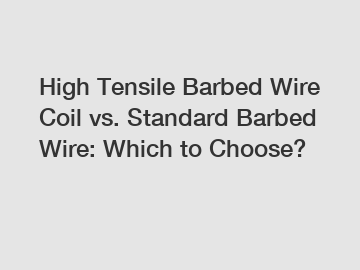Reinforcing Wire Rod vs. Traditional Materials for Bioenergy Plants
Nov. 04, 2024
Reinforcing Wire Rod vs. Traditional Materials for Bioenergy Plants
When considering the construction and operation of bioenergy plants, it's crucial to understand the materials used. Here, we address common questions related to the use of reinforcing wire rods compared to traditional materials.
1. What is reinforcing wire rod and how is it used in bioenergy plants?
Reinforcing wire rod is a type of steel reinforcement commonly used in construction. In bioenergy plants, it is used for various applications such as reinforcing concrete structures, supporting pipelines, and enhancing the durability of construction. Its tensile strength makes it ideal for structural reinforcement, ensuring that the plant can withstand various operational stresses.
2. How do reinforcing wire rods compare to traditional materials?
Traditional materials, such as timber and basic steel beams, have been used in construction for years. However, reinforcing wire rods offer significant advantages over these materials. They provide higher tensile strength and flexibility, which allows them to cope better with dynamic loads. Moreover, wire rods have a longer lifespan, reducing the need for frequent replacements or repairs, which can be both time-consuming and costly.
3. What benefits do reinforcing wire rods bring to the efficiency and sustainability of bioenergy plants?
Using reinforcing wire rods contributes to both efficiency and sustainability in bioenergy plants. Their strength allows for the construction of lighter and more efficient structures, which can lead to reduced material usage. This not only decreases construction costs but also lowers the carbon footprint associated with material production and transportation. Additionally, the long lifespan of wire rods supports the sustainability of the plant over time, as fewer replacements are needed.
Featured content:How to Choose the Best Mzp Tangled Wire Loops?
How to Determine Standard Five-layer Sintered Mesh Price in Thailand
What is 358 Security Mesh and Its Benefits?
Why Choose a 330 ft Fence Roll for Your Property?
Top 5 Benefits of Metal Mesh Panels for Every Project
What is Copper Clad Steel Wire Used For?
How to Choose Decorative Curled Steel Wire Mesh Brands
4. Are there any disadvantages to using reinforcing wire rods?
While reinforcing wire rods have numerous advantages, there are some potential downsides. They are generally more expensive than traditional materials initially, which can impact the overall budget of a bioenergy project. Furthermore, their installation may require specialized knowledge and skills, necessitating training or hiring experienced professionals, which can add to the project's cost.
5. How does the choice of materials impact the overall performance of a bioenergy plant?
The choice of materials significantly affects the overall performance of a bioenergy plant. Stronger materials like reinforcing wire rods can improve the plant's structural integrity, allowing it to operate more efficiently under various conditions. This enhances reliability, safety, and can contribute to better energy production. Ultimately, investing in high-quality materials can lead to lower operational costs and a more sustainable future for bioenergy generation.
In summary, while traditional materials have their place, reinforcing wire rods present distinct advantages that can enhance the construction and operation of bioenergy plants, promoting efficiency and sustainability in the long run.
If you are looking for more details, kindly visit Reinforcing Wire Rod for Bioenergy Plants, wire rod steel, Wholesale Hot Rolled Steel Bar Company.
Featured content:How to choose the right euro fence panels?
Are Your Bulk Steel Nails Delivering the Strength You Need?
How Can European Style Fencing Revolutionize Fitness?
Understanding Stainless Steel Wire Mesh Test Sieves Applications
Unlocking the Benefits of Hastelloy C-276 Mesh
The Advantages of Opting for a Stainless Steel Mesh Filter Screen Cap
Why Stainless Steel Wire is Essential Today?
140
0
0
Related Articles
-
164
0
0
-
Choosing Heavy Duty Field Fencing: A Complete Buyer’s Guide
# Choosing Heavy Duty Field Fencing: A Complete Buyer’s Guide.
122
0
0
-
126
0
0
-
134
0
0
-
Master Nails Construction: Top 5 Tips for Perfect Results!
## Mastering Nails Construction: Top 5 Tips for Perfect Results!
126
0
0
-
142
0
0
-
156
0
0
-
261
0
0









Comments
All Comments (0)